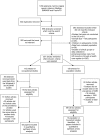Are reports of psychological stress higher in occupational studies? A systematic review across occupational and population based studies
- PMID: 24223840
- PMCID: PMC3817075
- DOI: 10.1371/journal.pone.0078693
Are reports of psychological stress higher in occupational studies? A systematic review across occupational and population based studies
Abstract
Objectives: The general health questionnaire (GHQ) is commonly used to assess symptoms of common mental disorder (CMD). Prevalence estimates for CMD caseness from UK population studies are thought to be in the range of 14-17%, and the UK occupational studies of which we are aware indicate a higher prevalence. This review will synthesise the existing research using the GHQ from both population and occupational studies and will compare the weighted prevalence estimates between them.
Methods: We conducted a systematic review and meta-analysis to examine the prevalence of CMD, as assessed by the GHQ, in all UK occupational and population studies conducted from 1990 onwards.
Results: The search revealed 65 occupational papers which met the search criteria and 15 relevant papers for UK population studies. The weighted prevalence estimate for CMD across all occupational studies which used the same version and cut-off for the GHQ was 29.6% (95% confidence intervals (CIs) 27.3-31.9%) and for comparable population studies was significantly lower at 19.1% (95% CIs 17.3-20.8%). This difference was reduced after restricting the studies by response rate and sampling method (23.9% (95% CIs 20.5%-27.4%) vs. 19.2% (95 CIs 17.1%-21.3%)).
Conclusions: Counter intuitively, the prevalence of CMD is higher in occupational studies, compared to population studies (which include individuals not in employment), although this difference narrowed after accounting for measures of study quality, including response rate and sampling method. This finding is inconsistent with the healthy worker effect, which would presume lower levels of psychological symptoms in individuals in employment. One explanation is that the GHQ is sensitive to contextual factors, and it seems possible that symptoms of CMD are over reported when participants know that they have been recruited to a study on the basis that they belong to a specific occupational group, as in nearly all "stress" surveys.
Conflict of interest statement
Figures






Similar articles
-
Home treatment for mental health problems: a systematic review.Health Technol Assess. 2001;5(15):1-139. doi: 10.3310/hta5150. Health Technol Assess. 2001. PMID: 11532236
-
Systemic pharmacological treatments for chronic plaque psoriasis: a network meta-analysis.Cochrane Database Syst Rev. 2021 Apr 19;4(4):CD011535. doi: 10.1002/14651858.CD011535.pub4. Cochrane Database Syst Rev. 2021. Update in: Cochrane Database Syst Rev. 2022 May 23;5:CD011535. doi: 10.1002/14651858.CD011535.pub5. PMID: 33871055 Free PMC article. Updated.
-
Systemic pharmacological treatments for chronic plaque psoriasis: a network meta-analysis.Cochrane Database Syst Rev. 2017 Dec 22;12(12):CD011535. doi: 10.1002/14651858.CD011535.pub2. Cochrane Database Syst Rev. 2017. Update in: Cochrane Database Syst Rev. 2020 Jan 9;1:CD011535. doi: 10.1002/14651858.CD011535.pub3. PMID: 29271481 Free PMC article. Updated.
-
Psychological and/or educational interventions for the prevention of depression in children and adolescents.Cochrane Database Syst Rev. 2004;(1):CD003380. doi: 10.1002/14651858.CD003380.pub2. Cochrane Database Syst Rev. 2004. Update in: Cochrane Database Syst Rev. 2011 Dec 07;(12):CD003380. doi: 10.1002/14651858.CD003380.pub3. PMID: 14974014 Updated.
-
A rapid and systematic review of the clinical effectiveness and cost-effectiveness of paclitaxel, docetaxel, gemcitabine and vinorelbine in non-small-cell lung cancer.Health Technol Assess. 2001;5(32):1-195. doi: 10.3310/hta5320. Health Technol Assess. 2001. PMID: 12065068
Cited by
-
Estimating the total prevalence of PTSD among the UK police force: Formal comment on Brewin, Miller and Burchell (2022).PLoS One. 2022 May 20;17(5):e0268400. doi: 10.1371/journal.pone.0268400. eCollection 2022. PLoS One. 2022. PMID: 35882372 Free PMC article. No abstract available.
-
Probable PTSD, depression and anxiety in 40,299 UK police officers and staff: Prevalence, risk factors and associations with blood pressure.PLoS One. 2020 Nov 12;15(11):e0240902. doi: 10.1371/journal.pone.0240902. eCollection 2020. PLoS One. 2020. PMID: 33180769 Free PMC article.
-
Impact of Psychosocial Factors on Mental Health and Turnover Intention Among Health Workers at Different Occupational Statuses: An Exploratory Cross-Sectional Study in China.Eur J Investig Health Psychol Educ. 2025 May 7;15(5):73. doi: 10.3390/ejihpe15050073. Eur J Investig Health Psychol Educ. 2025. PMID: 40422302 Free PMC article.
-
Sleep problems were unrelated to social media use in the late COVID-19 pandemic phase: A cross-national study.PLoS One. 2025 Jan 31;20(1):e0318507. doi: 10.1371/journal.pone.0318507. eCollection 2025. PLoS One. 2025. PMID: 39888926 Free PMC article.
-
Job Motivation, Burnout and Turnover Intention during the COVID-19 Pandemic: Are There Differences between Female and Male Workers?Healthcare (Basel). 2022 Aug 31;10(9):1662. doi: 10.3390/healthcare10091662. Healthcare (Basel). 2022. PMID: 36141274 Free PMC article.
References
-
- Goldberg DP (1972) The detection of psychiatric illness by questionnaire. Maudsley Monograph No. 21 . Oxford: Oxford University Press.
-
- McManus IC, Winder BC, Gordon D (1999) Are UK doctors particularly stressed? The Lancet 354: 1358–1359. - PubMed
-
- Craig R, Mindell J, Hirani V, (2009) Health Survey for England 2008. London: The Information Centre.
-
- Bara AC, Arber S (2009) Working shifts and mental health–findings from the British Household Panel Survey (1995–2005). Scand J Work Environ Health 35: 361–367. - PubMed
-
- Hotopf M, Hull L, Fear NT, Browne T, Horn O, et al. (2006) The health of UK military personnel who deployed to the 2003 Iraq war: a cohort study. The Lancet 367: 1731–1741. - PubMed
Publication types
MeSH terms
LinkOut - more resources
Full Text Sources
Other Literature Sources
Medical
Miscellaneous

